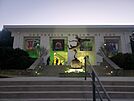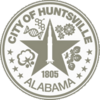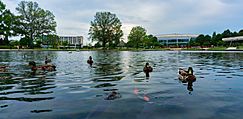Huntsville, Alabama facts for kids
Quick facts for kids
Huntsville
|
|||
|---|---|---|---|
|
Downtown Huntsville
|
|||
|
|||
| Nickname(s):
Rocket City
|
|||
| Motto(s):
"Star of Alabama"
|
|||
| Country | United States | ||
| State | Alabama | ||
| Counties | Madison, Limestone, Morgan | ||
| Established (as Twickenham) | December 23, 1809 | ||
| Incorporated (town) | December 9, 1811 | ||
| Incorporated (city) | February 24, 1860 | ||
| Founded by | LeRoy Pope | ||
| Named for | John Hunt | ||
| Government | |||
| • Type | Mayor–Council | ||
| Area | |||
| • City | 225.17 sq mi (583.19 km2) | ||
| • Land | 223.63 sq mi (579.21 km2) | ||
| • Water | 1.54 sq mi (3.98 km2) | ||
| Elevation | 577 ft (176 m) | ||
| Population
(2020)
|
|||
| • City | 215,006 | ||
| • Estimate
(2024)
|
241,114 |
||
| • Rank | US: 95th AL: 1st |
||
| • Density | 1,006/sq mi (388.3/km2) | ||
| • Urban | 329,066 (US: 122nd) 20,165 (Southeast) | ||
| • Urban density | 1,532.2/sq mi (591.6/km2) | ||
| • Metro | 514,465 (US: 109th) | ||
| • Metro density | 378/sq mi (145.9/km2) | ||
| • Combined | 879,315 (US: 68th) | ||
| • Combined density | 255.3/sq mi (98.57/km2) | ||
| Demonym(s) | Huntsvillian | ||
| Time zone | UTC−6 (Central (CST)) | ||
| • Summer (DST) | UTC−5 (CDT) | ||
| ZIP Codes |
35801–35816, 35824, 35893–35899
|
||
| Area code(s) | 256 and 938 | ||
| FIPS code | 01-37000 | ||
| GNIS feature ID | 2404746 | ||
Huntsville is the largest city in Alabama by population. It is also the 95th most populated city in the whole United States. Huntsville is located in northern Alabama, south of Tennessee. It is the main city of Madison County, but parts of it also reach into Limestone County and Morgan County.
The city was started in 1805 in what was then the Mississippi Territory. It became an official town in 1811. When Alabama became a state in 1819, Huntsville was its first capital for one year. The city grew near the Tennessee River and added textile mills in the late 1800s.
Huntsville grew a lot after World War II. The U.S. Army built Redstone Arsenal nearby. This site was first used for chemical weapons. After the war, it became a key place for developing rockets and space exploration technology. Today, NASA's Marshall Space Flight Center, the United States Army Aviation and Missile Command, and the FBI's support headquarters are all at Redstone Arsenal.
Because of its strong connection to space, Huntsville is often called "The Rocket City." In 2020, its population was 215,006 people.
Contents
History of Huntsville
Huntsville was officially made a city on November 25, 1811.
Early Days of Huntsville
By the early 1800s, most Native American groups had left this area. A trader named Ditto set up a spot by the river. In 1805, a Revolutionary War veteran named John Hunt settled near the Big Spring. The U.S. government made treaties with the Chickasaw (1805) and Cherokee (1806) to gain control of the land.

LeRoy Pope bought the land and named it Twickenham. This name came from the home village of his relative, Alexander Pope. The town was carefully planned around the Big Spring. However, because of anti-British feelings before the War of 1812, the town's name was changed in 1811 to "Huntsville" to honor John Hunt.
In 1811, Huntsville became the first incorporated town in what is now Alabama. But the city's "founding" year is considered 1805, when John Hunt arrived.
Growing Industries
Huntsville first grew rich from selling cotton. Many wealthy farmers moved here from other states to start new cotton plantations. The invention of the cotton gin made it easier to grow cotton in more places. This led to a greater need for slave labor across the South.
Huntsville, like other parts of Alabama, was involved in the slave trade. Enslaved people worked in factories and on cotton farms. Cotton mills, like the Bell Factory, used slave labor to run their machines. These mills helped Huntsville's economy grow a lot. By 1822, about 36% of Huntsville's population were enslaved people.
In 1819, Huntsville hosted a meeting where delegates wrote the constitution for the new state of Alabama. Huntsville became Alabama's first capital for a short time. Later, the capital moved to other cities like Cahaba and Montgomery.
In 1855, the Memphis and Charleston Railroad was built through Huntsville. This was the first railway to connect the Atlantic coast with the lower Mississippi River.
Huntsville During the Civil War

At first, Huntsville did not want to leave the Union in 1861. But many men from the city joined the Confederacy. The 4th Alabama Infantry Regiment, with two companies from Huntsville, fought bravely in the Battle of Manassas/Bull Run. Nine generals from the war were born near Huntsville. Five fought for the Confederacy, and four for the Union.
On April 11, 1862, Union troops led by General Ormsby M. Mitchel took control of Huntsville. They wanted to cut off the Confederacy's train lines. Union officers stayed in large homes, and soldiers camped outside the city. They looked for Confederate troops and weapons. Most of Huntsville was kept safe because Union officers and soldiers were living there.
After the Civil War
After the Civil War, Huntsville became a center for cotton textile mills. Companies like Lincoln, Dallas, and Merrimack built homes for their workers outside the city. These areas became small communities with schools, churches, and stores. Workers often had to buy goods from company stores. Only white people were allowed to work inside the mills. Black people worked outside as laborers.
During the 1930s, the Great Depression caused industry in Huntsville to slow down. Huntsville became known as the Watercress Capital of the World. This was because of the large amount of Watercress grown in the area.
Military and Space Exploration
In 1940, Huntsville was still a small city with about 13,000 people. This changed in 1941 when the U.S. Army chose land near the city for three chemical weapons factories. These factories, including Redstone Arsenal, operated during World War II. About 20,000 people worked there.
After the war, the factories were no longer needed. But Senator John Sparkman helped convince the Army to use Redstone Arsenal for developing rockets and missiles. In 1950, about 1,000 people, including 200 German scientists led by Wernher von Braun, moved to Redstone Arsenal from Fort Bliss, Texas. These scientists had been brought to the U.S. after World War II.
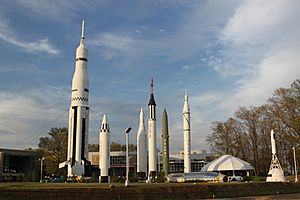
Huntsville is called "The Rocket City" because of its role in U.S. space missions. On January 31, 1958, America's first satellite, Explorer 1, was launched into orbit from Redstone Arsenal. This brought national attention to Huntsville as a major technology center.
On July 1, 1960, a large part of the Army's rocket team, including Wernher von Braun, moved to NASA to form the George C. Marshall Space Flight Center (MSFC). Von Braun became its first director. MSFC was key in developing the Saturn boosters used in the Apollo Lunar Landing Program. This led to many new companies coming to Huntsville. The Cummings Research Park was built to support this growth. It is now the second-largest research park in the U.S.
Civil Rights to Today
Huntsville played an important part in the Civil Rights Movement. In 1962, students from Alabama A&M University held the city's first lunch counter sit-in. The city worked to desegregate public places. On May 11, 1962, Huntsville became the first city in Alabama to integrate its public spaces.
In June 1963, two Black students were admitted to the University of Alabama in Huntsville. This happened despite challenges from Governor George Wallace. Huntsville also became the first city in Alabama to desegregate its schools.
NASA Administrator James E. Webb looked into equal job opportunities for Black people in Huntsville. This led MSFC to open its engineering programs to Black students at Alabama A&M and Oakwood College.
Today, Huntsville continues to be a leader in space and missile defense. It is involved in projects like the Space Shuttle, the International Space Station, and advanced missile defense systems.
Geography and Climate
Huntsville covers a large area of about 225.17 square miles (583.2 km2). It has grown by adding land in Limestone County and Morgan County. Huntsville is near the Tennessee River and borders several other cities and towns.
The city is surrounded by plateaus and large hills, which locals call "mountains." These include Monte Sano Mountain, Round Top, Chapman, and Green mountains. The land around Huntsville is karst in nature, meaning it has many caves underground. The city was founded around the Big Spring, a natural spring.
Weather in Huntsville
Huntsville has a humid subtropical climate. This means it has hot, humid summers and mild winters. The average high temperature is around 90 °F (32.2 °C) in summer and 49 °F (9.4 °C) in winter.
Huntsville gets a lot of rain, over 54 inches per year. The wettest months are usually from November to May. Thunderstorms are common, especially in spring and late fall. These storms can bring large hail, strong winds, and tornadoes. Huntsville is in an area called Dixie Alley, which is known for powerful tornadoes.
Heavy snow is rare in Huntsville, but it does happen sometimes. Notable snowstorms include New Year's Eve 1963 and the Blizzard of 1993.
Population of Huntsville
| Historical population | |||
|---|---|---|---|
| Census | Pop. | %± | |
| 1840 | 2,496 | — | |
| 1850 | 2,863 | 14.7% | |
| 1860 | 3,634 | 26.9% | |
| 1870 | 4,907 | 35.0% | |
| 1880 | 4,977 | 1.4% | |
| 1890 | 7,995 | 60.6% | |
| 1900 | 8,068 | 0.9% | |
| 1910 | 7,611 | −5.7% | |
| 1920 | 8,018 | 5.3% | |
| 1930 | 11,554 | 44.1% | |
| 1940 | 13,050 | 12.9% | |
| 1950 | 16,437 | 26.0% | |
| 1960 | 72,365 | 340.3% | |
| 1970 | 139,282 | 92.5% | |
| 1980 | 142,513 | 2.3% | |
| 1990 | 159,789 | 12.1% | |
| 2000 | 158,216 | −1.0% | |
| 2010 | 180,105 | 13.8% | |
| 2020 | 215,006 | 19.4% | |
| 2023 (est.) | 225,564 | 25.2% | |
| U.S. Decennial Census 2020 Census |
|||
Huntsville's Diverse Community
| Race / Ethnicity (NH = Non-Hispanic) | Pop 2000 | Pop 2010 | Pop 2020 | % 2000 | % 2010 | % 2020 |
|---|---|---|---|---|---|---|
| White alone (NH) | 100,333 | 104,516 | 118,616 | 63.42% | 58.03% | 55.17% |
| Black or African American alone (NH) | 47,453 | 55,615 | 62,360 | 29.99% | 30.88% | 29.00% |
| Native American or Alaska Native alone (NH) | 830 | 940 | 854 | 0.52% | 0.52% | 0.40% |
| Asian alone (NH) | 3,499 | 4,287 | 5,399 | 2.21% | 2.38% | 2.51% |
| Pacific Islander alone (NH) | 79 | 194 | 265 | 0.05% | 0.11% | 0.12% |
| Some Other Race alone (NH) | 173 | 260 | 878 | 0.11% | 0.14% | 0.41% |
| Mixed Race/Multi-Racial (NH) | 2,624 | 3,781 | 9,965 | 1.66% | 2.10% | 4.63% |
| Hispanic or Latino (any race) | 3,225 | 10,512 | 16,669 | 2.04% | 5.84% | 7.75% |
| Total | 158,216 | 180,105 | 215,006 | 100.00% | 100.00% | 100.00% |
As of the 2020 census, Huntsville had 215,006 people. The city is home to many different groups. About 55% of the people are White, and 29% are Black or African American. There are also people of Asian, Native American, and Pacific Islander backgrounds. About 7.75% of the population is Hispanic or Latino.
Huntsville's Economy
Huntsville's economy is mainly driven by aerospace and military technology. Key areas include Redstone Arsenal, Cummings Research Park (CRP), and NASA's Marshall Space Flight Center. CRP is the second largest research park in the U.S. The University of Alabama in Huntsville is a major center for technology and engineering research.
Many big companies have offices in Huntsville. These include ADTRAN (network access), Intergraph (computer graphics), and Avocent (IT infrastructure). Toyota Motor Manufacturing Alabama builds engines for Toyota vehicles. Mazda Toyota Manufacturing USA makes SUVs and pickup trucks.
Huntsville is also a leader in biotechnology. More than 25 biotech companies are here. The HudsonAlpha Institute for Biotechnology does important work in genomics and genetics. The University of Alabama in Huntsville offers a special program in biotechnology to train future scientists.
In 2018, Meta started building a large data center in Huntsville. It opened in 2021 and uses 100% renewable energy.
Arts and Culture in Huntsville
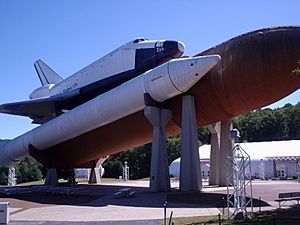
Historic Places and Museums
Huntsville has several historic districts. The Twickenham Historic District has homes built in the Federal and Greek Revival styles from the early 1800s. The 1819 Weeden House Museum was the home of artist and poet Howard Weeden. The Huntsville Depot, built in 1860, is Alabama's oldest train station.
The EarlyWorks Family of Museums runs several places. The EarlyWorks Children's Museum is an interactive history museum. Alabama Constitution Village shows what life was like in 1819. Burritt on the Mountain is a history museum and event place with a 1950s mansion and nature trails. The Huntsville Museum of Art has many art displays and educational programs.
The United States Space & Rocket Center is a famous museum. It features the United States Space Camp and a real Saturn V rocket. The U.S. Veterans Memorial Museum displays military vehicles and artifacts from different wars.
Libraries and Arts Events
The Huntsville-Madison County Public Library has many branches across the city. It has the highest number of books checked out in Alabama.
Arts Huntsville supports over 100 local arts groups. They promote visual arts with two galleries. The Huntsville Museum of Art opened in 1970. It has a large collection of art by American women.
Huntsville hosts several fun festivals. The Panoply Arts Festival happens every spring with art, music, and fireworks. The Cigar Box Guitar Festival in June features live music played on homemade instruments. The Galaxy of Lights is a holiday light show at the Huntsville Botanical Garden.
Performing Arts
Huntsville has a lively performing arts scene. The Huntsville Community Chorus Association has been performing since 1946. The Huntsville Symphony Orchestra is Alabama's oldest professional symphony. The Huntsville Youth Orchestra was started in 1961.
The Broadway Theatre League brings national Broadway shows to the city. Fantasy Playhouse Children's Theatre, founded in 1961, puts on plays for kids. Independent Musical Productions (IMP) stages musicals with local volunteers.
The Von Braun Center is a large event venue. It has an arena, a concert hall, and a playhouse. It hosts many different shows and events.
Local Breweries
Huntsville has several local breweries. These include Straight to Ale Brewery, Yellowhammer Brewing, Salty Nut Brewery, and Green Bus Brewing. Many are located in the Campus 805 area.
Sports in Huntsville
Huntsville is home to many sports teams and leagues. The Huntsville Havoc is a professional ice hockey team. They play their games at the Von Braun Center. Huntsville City FC is a new professional soccer team that started playing in 2023.
The Huntsville Adult Soccer League has seven teams. The Rocket City Roller Derby is a women's roller derby team. The Alabama–Huntsville Chargers (University of Alabama in Huntsville) have men's and women's basketball teams. The Alabama A&M Bulldogs have a men's football team.
Huntsville has many sports venues. The Von Braun Center can hold up to 9,000 people. Toyota Field is a baseball park for the Rocket City Trash Pandas team. Joe Davis Stadium was turned into a soccer stadium for Huntsville City FC. Other stadiums include Louis Crews Stadium and Milton Frank Stadium.
Parks and Recreation
Huntsville has over 60 parks. In 2013, Huntsville was named a 'Playful City USA' for its efforts to provide play opportunities for children.
Big Spring International Park is in downtown Huntsville. It has a natural spring, fish, ducks, and a waterfall. John Hunt Park is the city's largest park. It has tennis courts, soccer fields, and walking trails.
Burritt on the Mountain is a museum and event venue on Monte Sano Mountain. It has nature trails and great views. The Huntsville Botanical Garden has 112 acres (45 ha) of gardens, paths, and floral collections.
The Land Trust of North Alabama works to protect natural areas. Monte Sano State Park has over 2,000 acres (8.1 km2) for hiking, biking, and camping. Other state parks nearby include Cathedral Caverns and Lake Guntersville State Park.
Huntsville has six main golf courses. Hampton Cove is part of the Robert Trent Jones Golf Trail. The Links on Redstone Arsenal is for military and NASA members.
Education in Huntsville
Schools for Kids
Public schools in Huntsville are managed by Huntsville City Schools. In the 2022–2023 school year, over 23,900 students attended these schools. High school students in Huntsville have a 92% graduation rate.
The Huntsville City Schools system has:
- 26 Preschools (Pre-K)
- 28 Elementary schools (Kindergarten to 5th grade)
- 14 Middle schools (6th to 8th grade)
- 6 high Schools (9th to 12th grade)
- 3 special centers
Huntsville City Schools also offers six magnet programs. These programs are at existing schools and offer special learning opportunities. There are also several private Christian schools in Huntsville. Randolph School is Huntsville's only independent private school for K-12.
Colleges and Universities
Huntsville has four main colleges and universities. The University of Alabama in Huntsville is the largest, with over 9,600 students. About half of its graduates study engineering or science. It is known as a top research university.
Alabama A&M University is the oldest university in Huntsville, founded in 1875. It has over 5,000 students. Oakwood University, founded in 1896, is a Seventh-day Adventist university. J.F. Drake State Community and Technical College offers technical programs.
Other colleges also have locations in Huntsville. These include Calhoun Community College, Columbia College, and Embry–Riddle Aeronautical University.
Transportation in Huntsville
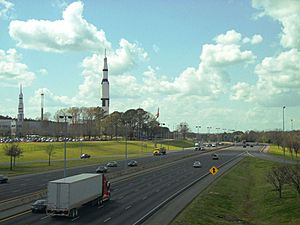
Huntsville is served by several major highways. These include US 72, US 231, and Interstate 565.
The city's public bus system is called the Huntsville Orbit. It has 11 routes around the city. Huntsville is also working to improve its bicycle paths and trails.
Huntsville has two active train lines for cargo. The main line is run by Norfolk Southern. The Huntsville and Madison County Railroad Authority operates another line. The Mercury and Chase Railroad offers fun weekend tourist rides on an old train line.
Air and Water Travel
The inland Port of Huntsville combines the Huntsville International Airport, a cargo center, and an industrial park. This allows for easy movement of goods by truck, train, and air. The airport has customs inspectors for international cargo.
Huntsville International Airport has flights from several airlines like Delta Air Lines and American Airlines. Delivery companies also have hubs here, with flights to Europe, Asia, and Mexico.
The Madison County Executive Airport is a smaller airport for private planes.
Notable People from Huntsville
Many famous people are from Huntsville. These include Wikipedia co-founder Jimmy Wales, professional wrestler Bobby Eaton, and film composer Mervyn Warren. Actress Tallulah Bankhead and horror actor David Howard Thornton are also from Huntsville.
Sister Cities
Huntsville has two sister cities:
 Tainan, Taiwan
Tainan, Taiwan Issy-les-Moulineaux, France, a suburb of Paris
Issy-les-Moulineaux, France, a suburb of Paris
Images for kids
-
Child workers at Merrimac Mills in Huntsville, November 1910, photograph by Lewis Hine
See also
 In Spanish: Huntsville (Alabama) para niños
In Spanish: Huntsville (Alabama) para niños



